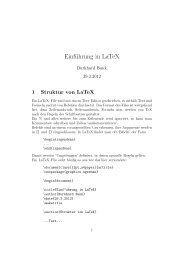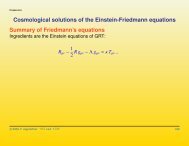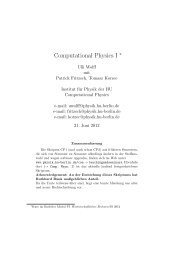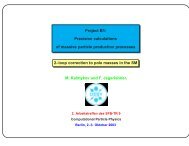Preprint[pdf] - HU Berlin
Preprint[pdf] - HU Berlin
Preprint[pdf] - HU Berlin
Create successful ePaper yourself
Turn your PDF publications into a flip-book with our unique Google optimized e-Paper software.
Π ′ γ ren(q 2 ) = − α<br />
�1<br />
π<br />
0<br />
= α<br />
π<br />
�<br />
0<br />
1<br />
dz 2z (1 − z) ln(1 − z (1 − z) q 2 /m 2 ℓ)<br />
dt t 2 (1 − t 2 /3)<br />
and performing the integral yields<br />
Π ′ γ ren(q 2 ) = − α<br />
3π<br />
1<br />
4m2 ℓ /q2 − (1 − t2 , (73)<br />
)<br />
� 8<br />
3 − β2 ℓ + 1<br />
2 βℓ (3 − β 2 ℓ) ln βℓ − 1<br />
βℓ + 1<br />
�<br />
, (74)<br />
where βℓ = � 1 − 4m2 ℓ /q2 is the lepton velocity. The imaginary part is given by the simple formula<br />
Im Π ′ γ (q2 ) = α<br />
�<br />
1 +<br />
3<br />
2m2 ℓ<br />
q2 �<br />
βℓ . (75)<br />
For q2 < 0 the amplitude Π ′ γ ren(q2 ) is negative definite and what is needed in Eq. (69) is −Π ′ (ℓ)<br />
γ (− x2<br />
1−x m2 µ)<br />
or Eq. (74) with βℓ = � 1 + 4 x2 ℓ (1 − x)/x2 , where xℓ = mℓ/mµ and mℓ is the mass of the virtual lepton in<br />
the vacuum polarization subgraph.<br />
Using the representation Eq. (69) together with Eq. (73) the VP insertion was computed in the late<br />
1950s [131] for mℓ = me and neglecting terms of O(me/mµ). Its exact expression was calculated in 1966 [132]<br />
and may be written in compact form as [35]<br />
A (4)<br />
2 vap (1/x)=−25<br />
lnx<br />
−<br />
36 3 + x2 (4 + 3 lnx) + x 4<br />
� � �<br />
2 π 1<br />
− 2 lnx ln − x − Li2(x<br />
3 x 2 �<br />
)<br />
+ x � 2<br />
1 − 5x<br />
2<br />
��π2 � �<br />
�<br />
1 − x<br />
− lnx ln − Li2(x) + Li2(−x)<br />
2 1 + x<br />
=− 25 lnx<br />
−<br />
36 3 + x2 (4 + 3 lnx) + x 4<br />
�<br />
2 ln 2 �<br />
(x) − 2 lnx ln x − 1<br />
�<br />
+ Li2(1/x<br />
x<br />
2 �<br />
)<br />
+ x � 2<br />
1 − 5x<br />
2<br />
��<br />
� �<br />
�<br />
x − 1<br />
− lnx ln + Li2(1/x) − Li2(−1/x) (x > 1) . (76)<br />
x + 1<br />
The first form is valid for arbitrary x. For x > 1 some of the logs as well as Li2(x) develop a cut and a<br />
corresponding imaginary part like that of ln(1 − x). Therefore, for the numerical evaluation in terms of a<br />
series expansion, it is an advantage to rewrite the Li2(x)’s in terms of Li2(1/x)’s, according to Eq. (A.11),<br />
which leads to the second form.<br />
There are two different regimes for the mass dependent effects, the light electron loops and the heavy tau<br />
loops [131,132]:<br />
• Light internal masses give rise to potentially large logarithms of mass ratios which get singular in the<br />
limit mlight → 0<br />
µ<br />
γ<br />
e<br />
γ γ<br />
a (4)<br />
�<br />
1 mµ<br />
µ (vap, e) = ln −<br />
3 me<br />
25<br />
+ O<br />
36<br />
� me<br />
mµ<br />
�� �α<br />
Here we have a typical result for a light field which produces a large logarithm ln mµ<br />
≃ 5.3, such that the<br />
me<br />
first term ∼ 2.095 is large relative to a typical constant second term −0.6944. Here the exact 2–loop result<br />
is<br />
a (4)<br />
�<br />
α<br />
�2 µ (vap, e) ≃ 1.094 258 3111(84) = 5.90406007(5) × 10<br />
π<br />
−6 . (77)<br />
30<br />
π<br />
� 2<br />
.


![Preprint[pdf] - HU Berlin](https://img.yumpu.com/3833433/30/500x640/preprintpdf-hu-berlin.jpg)




